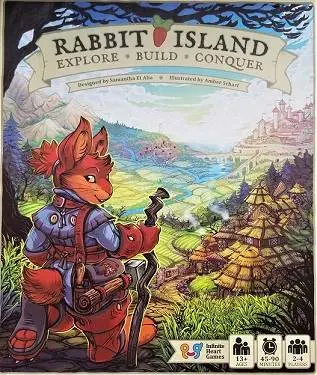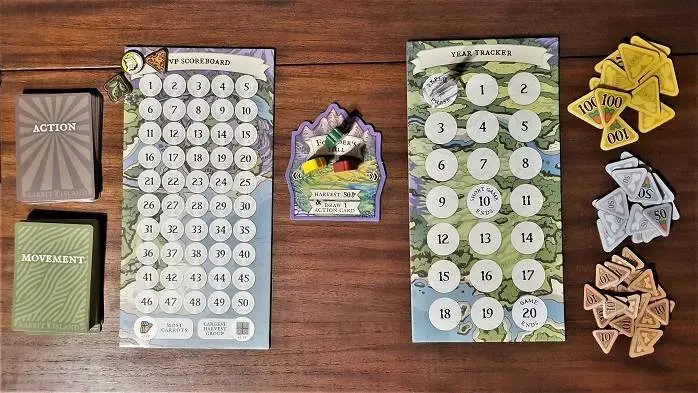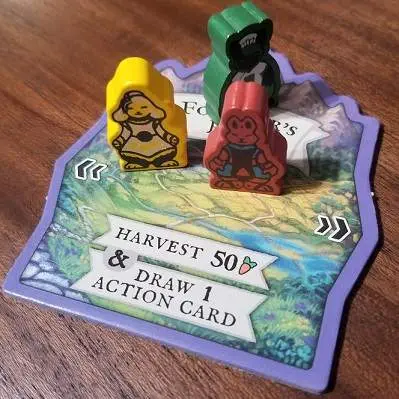
Four rabbit tribes, led by Russet, Acorn, Saffron, and Cobalt have each been wandering the seas looking for a new home. After months adrift, they discover a seemingly uninhabited island to explore and settle as their own. In Rabbit Island: Explore, Build, Conquer from Infinite Heart Games, 2-4 players will take on the roles of these lupine leaders and lead their band of roving rabbits to discover the unknown lands beyond Founder’s Hill: all in an attempt to be the most prosperous tribe.
Rabbit Island was successfully funded on Kickstarter way back in June of 2017 and reached more than twice its goal. The game is a combination of tile-laying and area control. It was designed by Samantha Et Alia and developed by Leslie Et Alia. The classic children’s book art style was provided by Amber Scharf of Studio Centerlight, whose contributions can also be found in other games including Museum: Pictura and Dominations. Those that backed the Kickstarter, in addition to the game, received a booklet of community content as well as an optional coloring book. Said booklet included short stories, recipes, and even more examples of Amber Scharf’s illustrations that added to the lore surrounding the Ignis, Herba, Memor, and Cursus tribes.

When playing Rabbit Island, players will need to decide if they’re going to play a full, standard game (45-90 minutes) or a short game (30-45 minutes). While the gameplay doesn’t change much, the setup does. This review is focusing on the standard game, but the rules and setup for both game lengths can be found in the rulebook included in the box. First and foremost, Founder’s Hill is separated from the other tiles and placed in the center of the play area. In the surrounding area, players will place the Rabbit Hole tiles, Collapse counters, Victory Point tracker, Year tracker, and shuffled decks of Movement and Action cards. Next, players will need to shuffle the Carrot Patch and Territory tiles together into a facedown stack. This also should be placed near the play area and within easy reach of all players. The players themselves will receive a player aid, 100 Carrot tokens, a rabbit pawn, building tokens in their tribe’s corresponding color, and a number of face-down map tiles based on the number of players. All remaining Carrot tokens are set aside to form a community bank and the extra map tiles are returned to the box. Each rabbit pawn is placed on Founder’s Hill before choosing a first player at random to begin the journey onward.

Rabbit Island is played over two main parts: the Explore Phase and the Build Phase. During the Explore Phase, players will take turns discovering the island by laying down tiles. When all players are done contributing to this stage of the game, it will come to a close, and the game will proceed to the Build Phase. It should be noted that the Explore Phase has now been permanently concluded and will not be revisited. The players will take turns building up the territories that were previously placed on the island during the Build Phase. After each player has taken a turn, the Year Tracker is moved ahead by one year. The game concludes at the end of year 20 and the Conquer Phase begins immediately. Tribes earn points during play by placing buildings, hoarding carrots, and having chains of connected territories under their control. In the end, the tribe with the most points will be declared the winner.
As Easter is coming up, we wanted to shine a spotlight on one of our favorite “rabbit games.” While Bunny Kingdom, Rabbit Rummage, and Killer Bunnies are all great choices, there is something about Rabbit Island that sets it completely apart. Perhaps it’s the attention to detail captured by both the artist and the designer, the replayability factor, or simply the fact that it’s a 4X game expertly camouflaged as a gateway game so nearly anyone can play it. Regardless of the reason, even after five years, Rabbit Island still holds up in our game group against the “cult of the new” with both children and adults alike. While many are drawn in by the adorable art, they stay for the depth of the gameplay. We will admit, there was a bit of a learning curve for those unused to the 4X genre, but within a game or two, those players were holding their own against other participants. Rabbit Island is a great – though somewhat hard to find – addition to anyone’s collection that we highly recommend picking up should you be lucky enough to find this rare gem hiding amongst the eggs this holiday!
All photos of Infinite Heart Games LLC.‘s products were taken and edited by Krista.